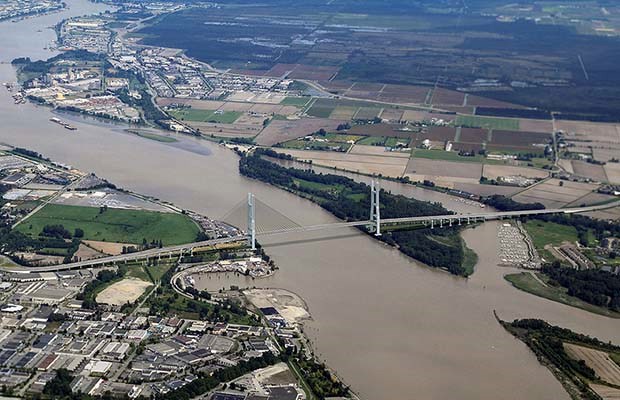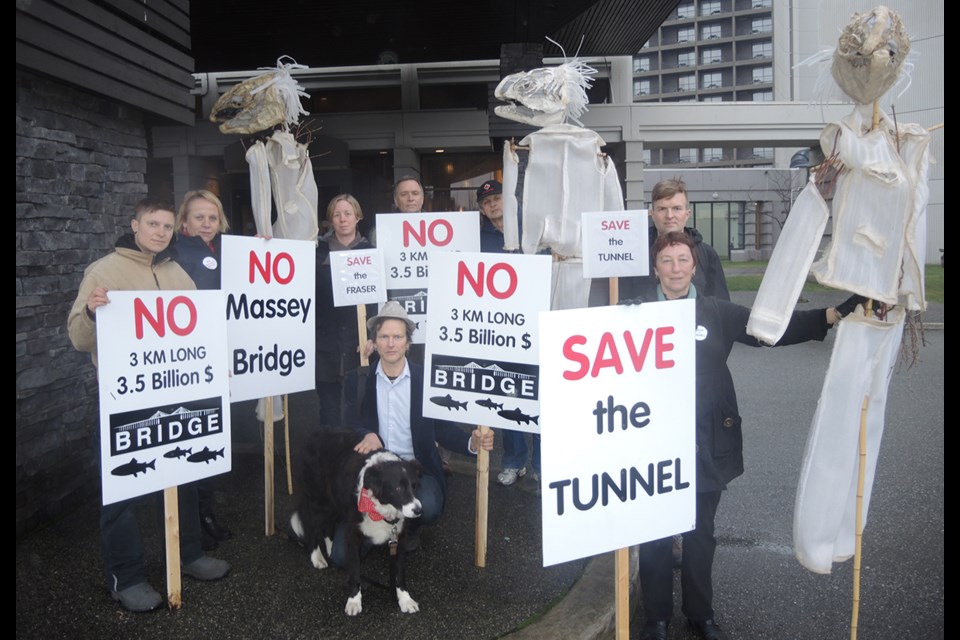A grassroots group of Richmond farmers and residents weathered the rain Tuesday to protest outside of the city’s only open house on the proposed Massey Tunnel Replacement Project.
The group, called Farmwatch, was trying to make its presence felt outside of the Sandman Signature Hotel on Edwards Drive in north Richmond with its “Stop the Bridge — Rally for the Massey Tunnel.”
Ironically, the B.C. government’s open house was being hosted at a hotel in the shadow of the Oak Street Bridge, where all concerned — project proponents and naysayers — have admitted the current traffic bottleneck will get worse if the new, 10-lane, $3.5 billion toll bridge is built further south on Highway 99.
Farmwatch, which is concerned about the degradation of farmland and farm ecosystems, is backing Richmond city council’s now vehement opposition to the bridge.
“So many questions about the bridge project remain unanswered and, as usual, there has not been proper public consultation,” said Farmwatch spokesperson Kimi Hendess.
Hendess wasn’t confident of getting any more answers at Tuesday’s open house, adding that, “so much of what is out there already is just lies.”
“There is simply no logical traffic rationale for the bridge and the information that’s out there is totally skewed.”
Hendess said it was clear from FOIs the group obtained that there have been email conversations between Port Metro Vancouver and the provincial government.
“It’s clear that the port is behind this project,” said Hendess.
“The (Massey) tunnel is the gatekeeper for the river. If that gets taken away…”
Hendess said a twinned tunnel is the only way forward and dismissed the B.C. government’s claim that there will be an actual net gain in farmland in Richmond as a result of the 3.5-kilometre bridge being built.
“There are no details on this supposed net gain, but it looks like we’re set to lose an entire swathe at the back of No. 5 Road,” said Hendess.
B.C.’s transportation minister, Todd Stone, said at a press conference in December there would be a gain of farmland in Richmond, but couldn’t provide any specifics as to how that was going to happen.
A second open house for the project is being held today (Wednesday), Jan. 27 in Delta, from 2 p.m. to 8p.m. in the Delta Town & Country Inn, 6005 Highway 17A.

Council debate bridge option
Prior to the protest, at a meeting on Monday night, Richmond city councillors debated the project, with accusations of conspiracy theories rebounding around city hall.
Councillors Alexa Loo and Ken Johnston support the proposed bridge while the majority of council prefers a new or improved tunnel. Coun. Chak Au said he wanted more information to compare the two options. However, council unanimously approved a set of demands if the bridge is built.
One of the demands the City of Richmond is making is improved traffic flow along the Oak Street Bridge. However, achieving this likely means having to get support from the City of Vancouver, whose council has generally taken measures to restrict the flow of traffic into its city, rather than ease it.
Ergo, Richmond's council created a motion asking Vancouver to address congestion at the intersection of 70th Avenue and Oak Street, which is thought to be a major contributor to the bridge's northbound bottleneck.
"We need to be working together," said Coun. Linda McPhail.
Coun. Bill McNulty expressed skepticism that Vancouver would get on board with such a plan.
"If I'm a councillor in Vancouver, 'sorry Richmond'" quipped McNulty.
Richmond councillors have taken issue with the limited information provided to the city and council, to date.
"We do not have specific information that would allow us to form any reasonable decision on this," said Mayor Malcolm Brodie.
Despite the lack of information and consultation Brodie and other councillors have expressed skepticism that the bridge is only intended to alleviate traffic congestion. It's been suggested the Ministry of Transportation and Port Metro Vancouver have ulterior motives for the bridge, related to opening the Fraser River up to deep sea ships (by way of dredging the river deeper, which cannot be done with the existing tunnel) and in turn further industrialization of the estuary.
Coun. Derek Dang suggested "someone from the Ministry of Transportation is sitting on the Grassy Knoll writing this (Project Definition) report."
To which Johnston replied: "I don't believe in conspiracy theories."
Johnston suggested anyone who does should be watching X-Files.
The former BC Liberal MLA, and president of a delivery company, said, "maybe they're interested in (a bridge) because it has nothing to do with ship traffic but that it has to do with getting the trucks through."
Johnston also questioned environmental concerns granted the bridge will alleviate idling at the tunnel (for 20 years).
Coun. Harold Steves said there is no plan to alleviate northbound idling at the Oak Street Bridge.
He said the bridge is an attempt to "Richmondize" Delta by virtue of opening up the South Fraser region to development. He added that there would be little incentive to add a light rail system within 20 years, as it would undermine tolling revenue.
Loo espoused the virtues of the planned bridge that have been expressed by the provincial government, such as the economic benefits of easing traffic congestion.
"We need a big bridge," said Loo.
She said the toll would be less than $10, the current minimum wage, and, on average, a driver will save over an hour each day by using the bridge.
"Time is money. …At the end of the day you're further ahead," said Loo.
Steves said the option to build a bridge only came to fruition over the last few years, after the port began lobbying the province for it.
One issue at large is earthquake readiness.
Steves contended the existing tunnel could be retrofitted for seismic upgrades.
But Loo said a bridge makes more sense in an emergency. Also, she said seismic work on the existing tunnel (or building a new one) would disturb fish habitat.
Meanwhile, Coun. Carol Day said a planned three-level interchange at Steveston Highway would be a "daunting structure" for nearby residents.
Dang said he regrets approving residential developments along the bridge's corridor, now knowing the scope of the project.
At the council meeting, Alex Nixon of the Richmond Poverty Response Committee said his organization opposed a bridge toll that would disproportionately impact low-income Richmondites.
John Terborg, a water systems engineer, told council the bridge project appeared to lack a connection between regional transportation planning and land-use planning.
Hendess said she was skeptical as to how the bridge would, as stated by provincial planners, result in a net gain of farmland.
"The devil is in the detail as to what will be lost and what will be gained," said Brodie.
Council also agreed to send a letter, however symbolic it may be, to the Canadian government to express its opposition to the project.
City of Richmond's demands IF a bridge must be built:
-Zero or positive impact on farmland
-Region-wide mobility pricing (a fair toll)
-Alleviate Oak Street Bridge congestion
-Improve local road network at no cost to city
-Ensure bridge is compatible with regional growth strategy
-Pedestrian and cycling access to overpasses/interchanges
-Iconic bridge design
-Ensure new transit stops supplied by Translink bus routes
GMT Project Definition Report Dec 2015



